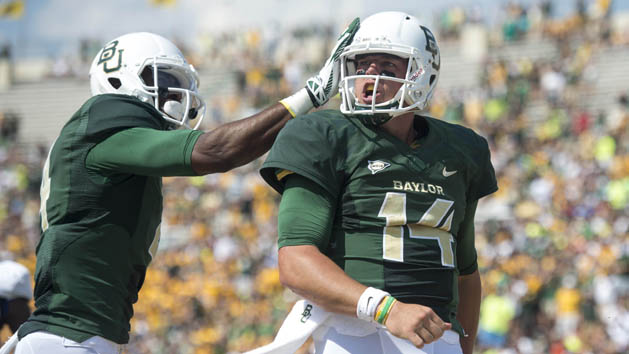
By now, in his sixth season coaching football at Baylor, Art Briles has made us forget just how bad the Bears were in the formative years of the Big 12.
Why, Baylor caught on quickly to the surge, approving construction of a new $260 million facility, which will replace aging Floyd Casey Stadium next season. That will prove to be a nice place to house the Heisman Trophy won by Robert Griffin III, who was on the front end of back-to-back bowl wins by the Bears.
Still, reminders of just how bad Baylor was before Briles’ arrival are worth revisiting. The Bears had won just 11 Big 12 games in the 12 seasons prior to hiring Briles. Yet he only shrugged at that task, promising a high-flying style that could keep pace with other fast-paced attacks in the trend-setting conference.
Now, it may just be Baylor that’s setting the pace. After scoring 69 points against Wofford, a Football Championship Subdivision opponent, on Week One, the Bears followed with a 70-13 rout of Buffalo. They amassed 781 yards of total offense while mounting seven scoring drives that required fewer than 90 seconds each. Included were back-to-back 28-point quarters.
All this with a new starter at quarterback, Bryce Petty, who threw for 338 yards.
“You don’t want to get to patting yourself on the back or anything, but I think our guys are pretty confident,” Briles said. “They know what they’re doing and I think we’re playing at a high rate of speed with a lot of effective plays, with some really good players doing it.”
The Bears can carve defenses any number of ways, though they’re going to always look deep. Over the last three seasons, they have thrown 22 touchdown strikes of 50 yards or more.
Eventually, Baylor’s withering pace exploits holes in defenses and causes opponents to collapse. Yet when addressing the issue, Petty was quick to credit teammates on the other side of the ball.
“We’ve got a great defense now,” Petty said of a unit that began making strides late last season. “Not to say they weren’t before but everybody’s kind of clicking on the same page as far as that side of the ball. Special teams is doing great. And then you know our offense, that’s what we expect to do. That’s our goal going in and that’s something we strive to do is to put points on the board and make yards.”
FIVE BIGGEST TAKEAWAYS FROM WEEK 2 IN THE BIG 12
1. Texas is in trouble. The embarrassing road blowout the Longhorns suffered at BYU again puts pressure on coach Mack Brown to either make some quick fixes or be saddled with a club that does not meet the high expectations Texas faces each season. Criticism of Manny Diaz boiled over after the defensive coordinator could not make the adjustments needed to blunt BYU’s devastating ground game. Much football remains, but Texas needs to regroup quickly and Brown, who has underachieved in recent seasons, heads that project.
2. Oklahoma figured to wallop West Virginia in the Big 12 opener, yet the Sooners struggled because they got little out of the passing game. That leaves a quarterback controversy that actually festered in fall camp when junior Blake Bell was not picked as starter. Bell should get some looks in practice leading into the Sept. 14 game against Tulsa, the last tune-up for the Sooners before they visit Notre Dame on Sept. 28. So far, the Oklahoma run game has made up for quarterback Trevor Knight’s inability to attack through the air.
3. Kansas State, which suffered a stunning defeat to two-time defending FCS champion North Dakota State in the opener, showed signs of life by downing Louisiana-Lafayette. The Wildcats scored in all three phases while subbing quarterback Daniel Sams for Jake Waters more often and showing a bit more diversity on offense. Defensive breakdowns late in the game add to concerns regarding inexperience, depth and conditioning, though Kansas State was better at the outset, racing to a 31-point lead.
4. TCU never really settled a quarterback duel that waged throughout fall camp between Casey Pachall and Trevone Boykin. Pachall, whose career pass efficiency rating is tops among active FBS quarterbacks, suffered a fractured left arm in a win against Southeastern Louisiana, leaving the offense to ride the legs and arm of Boykin, who responded well when summoned. If Boykin minimizes the mistakes that plagued him a year ago, the Horned Frogs could be in good hands. Their stingy defense is capable of pitching in and overcoming any adversity.
5. Oklahoma State became the second Big 12 team to win a true road game through the first two weeks of the season and by doing so, may have established that quarterback J.W. Walsh can actually throw. Known as the run threat in the duel waged with Clint Chelf, the starter in the season opener, Walsh completed 24-of-27 passes for 326 yards. His .889 completion percentage was the best of any OSU passer with at least 20 attempts in a game. Walsh completed his first 10 attempts and also had another string of 10 straight. He incorporated several targets, though most throws were short to intermediate, leaving open the question whether Walsh can strike deep.
